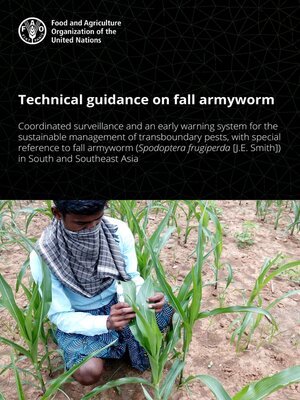Technical Guidance on Fall Armyworm
ebook ∣ Coordinated Surveillance and an Early Warning System for the Sustainable Management of Transboundary Pests, with Special Reference to Fall Armyworm (Spodoptera Frugiperda [J.E. Smith]) in South and Southeast Asia
By Food and Agriculture Organization of the United Nations

Sign up to save your library
With an OverDrive account, you can save your favorite libraries for at-a-glance information about availability. Find out more about OverDrive accounts.
Find this title in Libby, the library reading app by OverDrive.



Search for a digital library with this title
Title found at these libraries:
| Loading... |
Worldwide, maize is the third most important cereal after rice and wheat. It occupies 197 million hectares of planted area. Asia contributes to nearly 30 percent of global maize supplies, and area and production of the crop is rapidly increasing in the continent. Minimum support prices, swelling market demand from the animal feed and processing industries, as well as human consumption, have all led to increased maize production in zones where precipitation limits rice cultivation.
However, maize production is currently threatened by the arrival in Asia (in 2018) of the fall armyworm (FAW), Spodoptera frugiperda (J. E. Smith) – a native to North America. It invaded India in 2018 and since then it has marched to most of the Asian countries. In 2019, its presence was confirmed in 13 Asian countries including Cambodia, China, India, Indonesia, Japan, the Lao People's Democratic Republic, Malaysia, Myanmar, Nepal, the Philippines, the Republic of Korea, Sri Lanka, and Viet Nam. In 2020, it was confirmed in Australia, Timor-Leste and Papua New Guinea. In August 2021, it reached the Solomon Islands, posing a serious threat to other Pacific islands. FAW is a fast-dispersing, migratory, transboundary insect pest. While high FAW incidences have been reported on several crops in Asia, the most important economic damage caused is to maize (followed by sorghum). The FAW invasion threatens the food security of millions of family farms in Asia, with smallholder farmers being especially vulnerable. The negative economic impact of FAW is not only evident in yield loss: the pest also leads to a significant increase in insecticide applications, with associated health, environmental and cost issues. At the same time, resilience to FAW on the continent is currently weakened by the limited access to necessary tools, technologies and sustainable integrated pest management (IPM) practices for FAW. Thus, there is an urgent need to implement an effective approach to FAW management in Asia.






